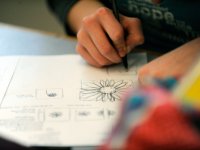Arts Integration or Arts and Crafts?
Arts integration is a gateway for engagement, motivation, and creativity as students use critical thinking skills to they learn content through relevant and individualized projects.
Your content has been saved!
Go to My Saved Content.Research shows that one of the best ways to engage students in content learning is to incorporate the arts. Because of students' openness to the arts, their motivation remains high, their attention spans tend to be longer, and their learning increases -- yet teachers sometimes struggle with how to incorporate the arts while maintaining academic integrity. No matter what type of the arts you desire to bring into the classroom -- music, visual art, creative writing, dance, etc. -- here are five guidelines to help prevent arts integration in the content classroom from simply becoming arts-and-crafts time.
1. Arts integration should be connected to a standard.
Common Core standards lend themselves beautifully to arts integration. Whether the arts are used as an entry point to a lesson to pique student interest or as a culminating project to assess student knowledge, standard alignment is essential. Several museums, centers, and education sites offer detailed lessons, across the disciplines and for various grade levels, which are aligned to standards and maintain an academic focus. For example, the Getty, the Rock and Roll Hall of Fame, and the Kennedy Center are great places to begin exploring ideas of how the arts can tie to standards.
2. Arts integration projects should reflect learning.
In addition to alignment with standards, teachers should clearly identify and state the desired learning outcomes before students begin creating. Wording such as "students will understand" and "students will demonstrate" narrows the focus and outlines clear learning goals. Using arts in the classroom will free students to look at content from different perspectives while clear communication from the teacher in the beginning and continued dialogue through the process will ensure student focus on learning goals.
3. Arts integration should involve student choice.
Just as students have different learning styles or multiple intelligences, they gravitate toward different forms of the arts. Some will prefer visual art, while others prefer dance. Music will be some students' forte, while others are natural performers. Allowing them to create and express themselves through their choice of the arts makes learning personal and relevant. Offer options for self-expression through visual arts by painting, sculpting, graffiti, photography, or drawing; or through music by composing or performing in different genres. Those who love the spotlight may want to perform monologues, vignettes, dance pieces, or direct their classmates' performances, while others may be more inclined to write poetry or short stories. Some projects can cross the lines of different learning styles, such as film, graphic novels or comics, or musical theater. Instead of offering students a choice of two or three options, invite them to propose their own projects so that they're free to dream, create, and fully own their learning. For culminating or extended projects, students may collaborate and construct projects showcasing a variety of the arts. The sky is truly the limit.
4. Arts integration projects should have specific grading rubrics.
Developing a specific rubric can alleviate fears and uncertainty for both teachers and students. While your specific rubric may have more categories, projects involving the arts should include three basic categories for assessment:
- Content: Content assessment includes how well the project reflects the standard and mastery of the content.
- Process: The process evaluation includes the use of higher-order thinking skills, planning and organization, and overall student effort.
- Product: The product assessment is where many teachers feel unqualified to offer feedback because of their lack of knowledge or experience in a particular discipline of the arts. Focus on whether the content is clearly reflected in the finished product and the quality of the product or performance when assessing the product.
A student reflection, whether written or spoken, can serve as a valuable tool when assessing what the student learned and how well the product ties to the content. Art, theater, and music teachers can be a great resource for content teachers feeling uncertain about assessment or arts integration in general.
5. Arts integration projects should be shared with others.
Learning best occurs when the student becomes the teacher, and while sharing a project doesn't seem like formal teaching, the experience offers a chance to showcase learned information. Exhibit projects not just in the classroom but throughout the school, especially for open house or other special events, or host a gallery walk to display the visual arts. Dance or small theater performances can be held for younger classes or during lunch. The local theater, coffee shops, county offices, or civic-minded businesses are often willing to display work or host school-sponsored readings of original works or dramatic interpretations. Allow students to shine in front of some type of audience.
Arts integration in the modern classroom serves as a gateway for student engagement, motivation, and creativity. Not only will students benefit, but teachers also reap the rewards of having students use critical thinking skills and flourish in learning content through relevant and individualized projects.
